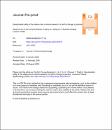Controversy and Debate: Questionable utility of the relative risk in clinical research: Paper 1: A call for change to practice
| Author | Suhail A., Doi |
| Author | Furuya-Kanamori, Luis |
| Author | Xu, Chang |
| Author | Lin, Lifeng |
| Author | Chivese, Tawanda |
| Author | Thalib, Lukman |
| Available date | 2020-11-17T05:19:45Z |
| Publication Date | 2020-11-07 |
| Publication Name | Journal of Clinical Epidemiology |
| Identifier | http://dx.doi.org/10.1016/j.jclinepi.2020.08.019 |
| Citation | : Doi SA, Furuya-Kanamori L, Xu C, Lin L, Chivese T, Thalib L, Questionableutility of the relative risk in clinical research: A call for change to practice, Journal of ClinicalEpidemiology (2020), doi:https://doi.org/10.1016/j.jclinepi.2020.08.019 |
| ISSN | 08954356 |
| Abstract | Background and Objectives In clinical trials, the relative risk or risk ratio (RR) is a mainstay of reporting of the effect magnitude for an intervention. The RR is the ratio of the probability of an outcome in an intervention group to its probability in a control group. Thus, the RR provides a measure of change in the likelihood of an event linked to a given intervention. This measure has been widely used because it is today considered a measure with “portability” across varying outcome prevalence, especially when the outcome is rare. It turns out, however, that there is a much more important problem with this ratio, and this paper aims to demonstrate this problem. Methods We used mathematical derivation to determine if the RR is a measure of effect magnitude alone (i.e., a larger absolute value always indicating a stronger effect) or not. We also used the same derivation to determine its relationship to the prevalence of an outcome. We confirm the derivation results with a follow-up analysis of 140,620 trials scraped from the Cochrane. Results We demonstrate that the RR varies for reasons other than the magnitude of the effect because it is a ratio of two posterior probabilities, both of which are dependent on baseline prevalence of an outcome. In addition, we demonstrate that the RR shifts toward its null value with increasing outcome prevalence. The shift toward the null happens regardless of the strength of the association between intervention and outcome. The odds ratio (OR), the other commonly used ratio, measures solely the effect magnitude and has no relationship to the prevalence of an outcome in a study nor does it overestimate the RR as is commonly thought. Conclusions The results demonstrate the need to (1) end the primary use of the RR in clinical trials and meta-analyses as its direct interpretation is not meaningful, (2) replace the RR by the OR, and (3) only use the postintervention risk recalculated from the OR for any expected level of baseline risk in absolute terms for purposes of interpretation such as the number needed to treat. These results will have far-reaching implications such as reducing misleading results from clinical trials and meta-analyses and ushering in a new era in the reporting of such trials or meta-analyses in practice. |
| Language | en |
| Publisher | Elsevier |
| Subject | binary effect measure relative risk odds ratio risk difference posterior probability |
| Type | Article |
| Open Access user License | http://creativecommons.org/licenses/by/4.0/ |
Check access options
Files in this item
This item appears in the following Collection(s)
-
Medicine Research [1857 items ]



